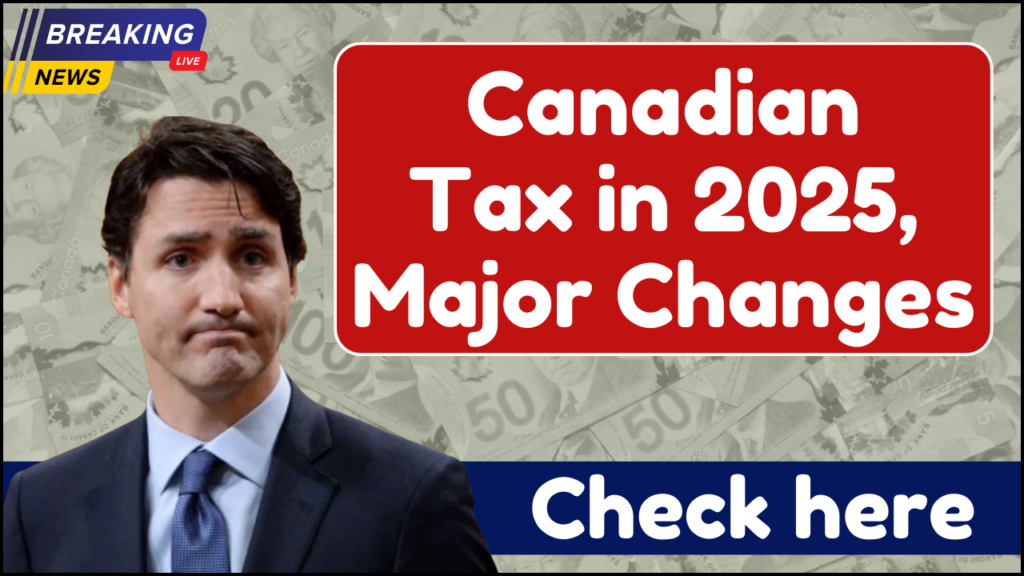
Canada’s tax system is set for some key changes in 2025 that will affect individuals and businesses. These updates aim to help people save more, manage their finances better, and adapt to rising costs. Here’s a simple guide to these changes and how they could impact you.
Updated Tax Brackets
The government has adjusted federal tax brackets to make things fairer for taxpayers. This means people can keep more of their income before moving into higher tax rates. The details are in the table below:
| Income Range | Old Tax Rate | New Tax Rate |
|---|---|---|
| Up to $53,359 | 15% | 15% |
| $53,360 to $106,717 | 20.5% | 20.5% |
| $106,718 to $165,430 | 26% | 26% |
| $165,431 to $235,675 | 29% | 29% |
| Over $235,676 | 33% | 33% |
Canada’s New Disability Benefit $2,400 Annually, Check Eligibility and Key Details
Canada’s Extra GST Payment 2025, check Eligibility and Payment Details
Canada’s Extra GST Payments for 2025, Your Complete Guide to Eligibility and Benefits
CRA $250 Rebate for Working Canadians, Check Eligibility, Payment Timeline
While the rates haven’t changed, the bracket limits have been raised so more income gets taxed at lower rates. This is good news for middle-income earners.
Canada Pension Plan (CPP) Increase
The Canada Pension Plan will increase payouts by 4.4% in 2025. This change will give retirees a little extra money every month, helping them manage living expenses. Workers contributing to the CPP will see this reflected in their future benefits too.
Higher Savings Limits for TFSA and RRSP
- TFSA Changes: The annual contribution limit for Tax-Free Savings Accounts (TFSA) is increasing to $7,000 in 2025, up from $6,500 in 2024. This means you can save and invest more without paying taxes on earnings.
- RRSP Changes: The limit for Registered Retirement Savings Plan (RRSP) contributions will rise to $32,249 from $31,560 in 2024. This helps you save more for retirement and delay paying taxes on those savings until later.
Both changes are designed to help Canadians build their savings faster and more effectively.
Alternative Minimum Tax (AMT) Updates
The Alternative Minimum Tax is designed to ensure wealthier individuals pay their fair share of taxes. In 2025, the AMT exemption will go up to $173,000 from $40,000. The tax rate will also increase to 20.5% from 15%. This means only higher earners will pay this tax, but they will contribute a bit more.
Employment Insurance (EI) Premiums Rising
Employment Insurance (EI) premiums will go up slightly in 2025. This increase will help the government fund EI benefits for Canadians who lose their jobs. While this means slightly higher paycheck deductions, it also supports more people in tough times.
Higher Carbon Tax
Canada is raising its carbon tax to $80 per tonne in 2025, up from $65 per tonne in 2024. This will make fuel and energy costs higher, but the government hopes it will encourage greener choices. To help with these costs, eligible Canadians can apply for carbon tax rebates.
Boost to Old Age Security (OAS)
Seniors receiving Old Age Security (OAS) will get more money in 2025. The exact amount will depend on inflation and individual circumstances, but this increase is meant to help seniors cover rising living costs.
Filing Your Taxes: What to Know
To make sure you get all your tax credits and benefits, you need to file your tax return on time. You are eligible to file if you:
- Are a Canadian citizen or permanent resident.
- Earn income from Canada or abroad.
- Qualify for provincial benefits like GST/HST credits.
- Have been asked by the Canada Revenue Agency (CRA) to file a return.
Filing on time ensures you get benefits like the Canada Child Benefit and avoid penalties.
What Do These Changes Mean for You?
- For Individuals: Higher savings limits and adjusted tax brackets can give you more opportunities to save and keep more of your income.
- For Businesses: Adjustments like the carbon tax and changes to employment premiums may mean higher costs but also push for greener practices.
- For Seniors: Bigger CPP and OAS payments are a welcome change to help manage expenses in retirement.
FAQs
Q1: How does the new TFSA limit help me?
Ans: You can now save up to $7,000 in your TFSA in 2025. Any earnings in this account are tax-free, which helps grow your money faster.
Q2: What’s the benefit of the CPP increase?
Ans: Retirees will get more money from their CPP each month, and current workers’ future payouts will be larger too, helping with retirement costs.
Q3: How does the AMT change affect me?
Ans: Only high earners are impacted by the higher AMT exemption and rate. For most Canadians, these changes won’t apply.
Conclusion
The 2025 tax changes aim to make things fairer and help Canadians save and plan better. While some updates, like the carbon tax, may raise costs, others, like higher savings limits and pension increases, bring financial benefits. To make the most of these changes, stay informed and consider consulting a tax advisor.